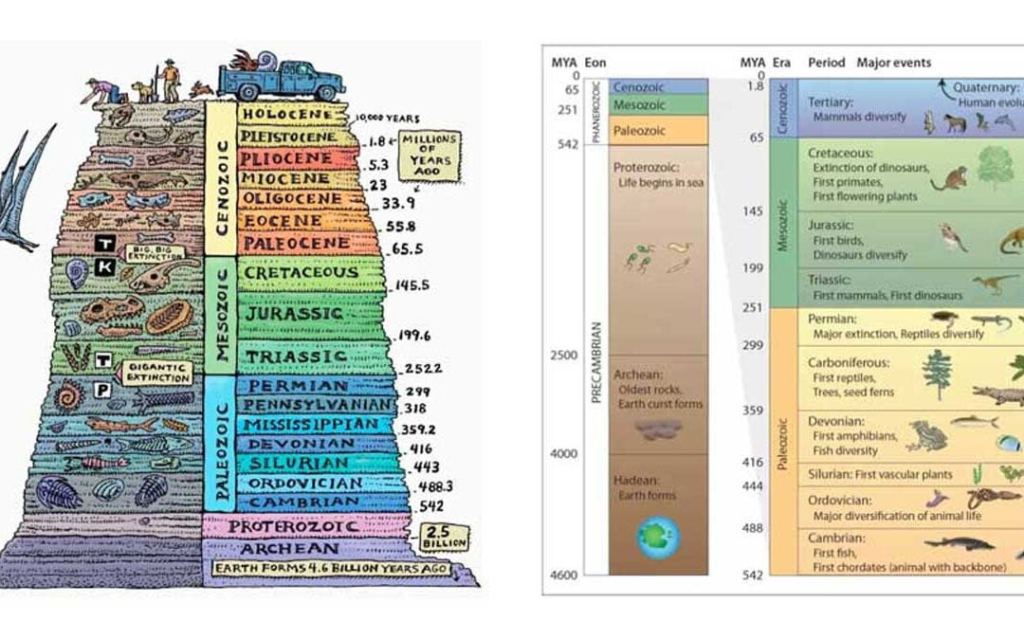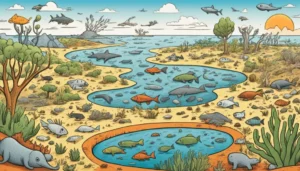Introduction
When we think of time, we often think in days, years, or maybe centuries. But geology demands we stretch our imagination beyond kings and civilizations, past ice ages and meteor impacts, into a history that spans 4.6 billion years. This grand history is captured in the Geological Time Scale (GTS) a framework that allows scientists to organize and understand the vast history of Earth, layer by layer, fossil by fossil.
The Geological Time Scale is like Earth’s ultimate diary, chronicling every major chapter from the planet’s birth to the rise of life and the shaping of its continents. It’s a story written in rock, and reading it is one of the most profound pursuits in geology.
What is geological time scale?
The Geological Time Scale is a chronological system used by geologists and paleontologists to describe the timing and relationships of events that have occurred during Earth’s history. Instead of years or centuries, the GTS is divided into eons, eras, periods, epochs, and ages, each defined by significant geological or biological events, like mass extinctions, climate shifts, or the appearance of new life forms.
The GTS is built from both relative dating (based on fossil succession and rock layering) and absolute dating (using radiometric techniques). Combined, these methods allow scientists to date rocks and fossils with remarkable accuracy.
Eons of Earth’s history

Hadean Eon (~4.6 to 4.0 billion years ago)
This is the mysterious and fiery infancy of the planet. The Earth was just forming from dust and gas around the young Sun. It was a violent time, marked by frequent asteroid impacts, molten surfaces, and the formation of the Moon. Very few rocks from this time survive today, but it laid the foundation for all that followed.
Archean Eon (~4.0 to 2.5 billion years ago)
During the Archean, the Earth began to cool. The first continents started to form, and more importantly, the earliest known life, simple single-celled organisms like bacteria, emerged. The atmosphere had little oxygen, and life was exclusively microbial.
Proterozoic Eon (~2.5 billion to 541 million years ago)
The Proterozoic saw the rise of oxygen in the atmosphere, thanks to photosynthesizing cyanobacteria. This period also witnessed the first eukaryotic cells (with nuclei), multicellular organisms, and snowball Earth events—global glaciations that may have frozen the entire planet. It ended with the Ediacaran biota, a strange collection of soft-bodied life forms.
Phanerozoic Eon (541 million years ago to present)
The Phanerozoic is the eon of visible life. It’s divided into three major eras and contains most of the life forms we know today, from trilobites to dinosaurs to humans. This is where fossils become abundant and the story of life truly blossoms.
Eras and Periods of the Phanerozoic
Paleozoic Era (541–252 million years ago)
Often called the “Age of Ancient Life,” the Paleozoic began with the Cambrian Explosion, when most major animal groups first appeared. Life thrived in oceans with trilobites, brachiopods, and early fish. Plants and animals gradually colonized land, and giant ferns and insects ruled the Carboniferous swamps. It ended in catastrophe, the Permian-Triassic extinction, Earth’s largest known mass extinction, wiping out over 90% of species.
Key periods:
- Cambrian: Sudden appearance of diverse marine life.
- Ordovician & Silurian: First vertebrates and land plants.
- Devonian: Age of fishes; first amphibians.
- Carboniferous: Coal-forming forests, large insects.
- Permian: Pangaea forms; ends with mass extinction.
Mesozoic Era (252–66 million years ago)
Known as the “Age of Reptiles,” this era saw the rise and fall of dinosaurs. The Mesozoic also included the breakup of Pangaea, the first birds, and flowering plants. It ended with the famous Cretaceous-Paleogene extinction, likely caused by an asteroid impact, that wiped out the dinosaurs and paved the way for mammals to dominate.
Key periods:
- Triassic: Early dinosaurs and mammals.
- Jurassic: Giant sauropods, first birds.
- Cretaceous: Flowering plants, mass extinction event.
Cenozoic Era (66 million years ago to present)
The “Age of Mammals” saw mammals and birds diversify to fill the niches left by dinosaurs. The Earth’s climate cooled, leading to the Ice Ages, and continents drifted into their modern positions. Humans emerged in the last few million years
Key periods/epochs:
- Paleogene & Neogene Periods: Expansion of grasslands, evolution of whales and primates.
- Quaternary Period: Ice Ages, rise of Homo sapiens.
How the GTS Is Used in Geology
Geologists use the Geological Time Scale as a reference framework for:
- Dating rocks and fossils.
- Correlating strata between different locations.
- Understanding Earth’s history of climate change, evolution, and tectonics.
- Predicting natural resources like oil, gas, and coal, which often form during specific geological periods.
Fossils act like bookmarks, helping geologists identify specific intervals of time based on the life forms present in the rock record. For example, if you find an ammonite fossil, you’re likely in the Jurassic period.


